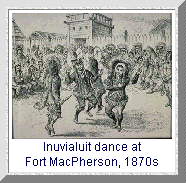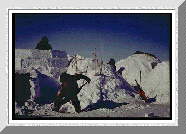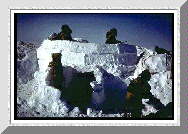


The People - Villages
At the time of European contact in the early 19th century, the Inuvialuit were divided into half a dozen distinct territorial groups or "nations." Most seem to have had a main village from which they took their name, with the added suffix "...miut" meaning "people of." Thus, the Kittegaryumiut were the "people of Kittigazuit," a large village near the mouth of the Mackenzie River, while the Avvagmiut were the "people of Avvak," a village at Cape Bathurst. Inuvialuit nations varied in size from a few hundred to nearly a thousand people.


All told there were at least 2500 Inuvialuit in the early 19th century, about as many as the total number of Inuit living in the rest of Arctic Canada as far east as Hudson Bay. They lived in perhaps the richest area of northern Canada, with a population density many times that of the Central Arctic. With their rich villages, permanent log-and-sod houses, and powerful chiefs, the Inuvialuit considered their Inuit neighbours to the east to be (in the words of an early missionary) "outright savages."
Inuvialuit villages typically consisted of a group of large log-and-sod houses dug partially into the ground for warmth. They were often multi-family houses built in a cross-shaped pattern, but single-family dwellings were also used. Walls were made of vertical poles stuck into the ground and slanted in slightly toward the top, so that sod insulation stacked against it remained in place. Floors were recessed below ground level to help conserve warmth, and the primary entrance was through a "cold trap" tunnel framed in driftwood. Heat and light were supplied by oil lamps, well attested from historical sources, while most archaeologically-excavated houses also give evidence of large interior hearths. Villages could range in size from a single house to as many as thirty, with three to ten houses being fairly typical.
These were primarily winter houses although some of the better-drained examples probably sometimes did double duty in summer as well, when they offered a cool, dark respite from the mosquitoes and the endless midnight sun. But most people coming to a major village for the summer hunt would have had to live in tents, since their winter houses were elsewhere. As the explorer Stefansson described it, "Kittegaryuit was a large village only in summer. In winter the people scattered...."
Inuvialuit also lived in snowhouses, particularly later in the winter when their autumn food stores had been consumed.



As well as dwellings, major villages also included "dance houses" or karigi. These buildings are described as being fifty to sixty feet in length (about 15 to 20 metres), framed in driftwood, with an entranceway covered by a beluga skin, a large central hearth, and a bench which ran around the inside wall. They were the location of important ceremonies, and were used for dancing and the repair and manufacture of tools.

[Opening Page | The Land | The People | From Ancient Times | ...To 1902 | Survival |About the Researcher]